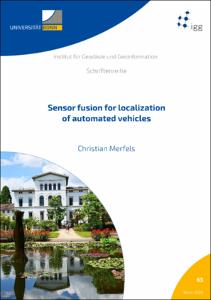Sensor fusion for localization of automated vehicles

Sensor fusion for localization of automated vehicles

| dc.contributor.author | Merfels, Christian | |
| dc.date.accessioned | 2020-08-31T13:51:39Z | |
| dc.date.available | 2020-08-31T13:51:39Z | |
| dc.date.issued | 2020 | |
| dc.identifier.uri | https://hdl.handle.net/20.500.11811/8563 | |
| dc.description.abstract | Automated vehicles need to precisely know where they are at all times to be able to make informed driving decisions. Therefore, multiple localization systems are typically installed on such vehicles to provide redundant position estimates based on different sensors. Thus, an important task is the fusion of these position estimates into a single estimate. The goal of this thesis to develop a new approach to solve this sensor fusion problem in a generic way to achieve high modularity, interchangeability, and extensibility, while at the same time assuring high precision, robustness, and availability.
Generic approaches to sensor fusion for localization systems face the difficulty that only general assumptions can be made about their input data. These generic assumptions make it complicated to model the error of each input source differently. We approach this challenge by presenting a novel layer architecture that can be modularly adapted. The core of our generic fusion approach is an optimization method that combines all available position and odometry measurements. We formulate a sliding window pose graph over these measurements to estimate the most probable trajectory of the vehicle. In a preprocessing sublayer, the measurements are adjusted so that different common error characteristics are either reduced or can be taken into account in the estimation process. These include systematic, autocorrelated, and cross-correlated errors as well as outliers. We derive different preprocessing modules for each of these error modes. In this thesis, we extend the pose graph model to represent the effects of autocorrelated errors and marginalization. We implement our approach and evaluate it using simulated data as well as data gathered on real prototype vehicles. In experiments, we show that the estimation method scales from a filtering-based to a batch solution depending on the available computational resources. In addition, we demonstrate that our preprocessing modules reduce the effects of the described error characteristics. Overall, we develop a generic fusion of position estimates, which is a key component of automated vehicles. | en |
| dc.description.abstract | Automatisierte Fahrzeuge müssen jederzeit genau wissen, wo sie sich befinden, um fundierte Fahrentscheidungen treffen zu können. Deshalb sind auf solchen Fahrzeugen üblicherweise mehrere Lokalisierungssysteme installiert, um redundante Positionsschätzungen auf Basis unterschiedlicher Sensoren zu ermöglichen. Hieraus ergibt sich die zentrale Aufgabe der Fusion von diesen Positionsinformationen in eine einzige Schätzung. Das Ziel dieser Arbeit ist es, diese Fusion auf eine generische Art und Weise zu gestalten, um eine hohe Modularität, Austauschbarkeit und Erweiterbarkeit zu erzielen und gleichzeitig eine hohe Genauigkeit, Robustheit und Verfügbarkeit zu gewährleisten. Solche generischen Fusionsansätze für Lokalisierungssysteme bergen die Schwierigkeit, dass nur allgemeine Annahmen über die zu fusionierenden Eingangsdaten getroffen werden können. Diese generischen Annahmen erschweren eine auf jede Eingangsquelle abgestimmte Fehlermodellierung. Um dennoch eine differenzierte Verarbeitung zu ermöglichen, stellen wir eine neue Schichtenarchitektur vor, die modular angepasst werden kann. Der Kern unseres generischen Fusionsansatzes bildet ein Optimierungsverfahren, in dem alle vorhandenen Positions- und Eigenbewegungsmessungen kombiniert werden. Dazu konstruieren wir einen Posengraphen über alle Messungen im letzten Zeitfenster, um so die wahrscheinlichste gefahrene Trajektorie zu schätzen. In einer Vorverarbeitungsschicht werden die Messdaten so angepasst, dass verschiedene in der Praxis häufig auftretende Fehlercharakteristiken entweder reduziert oder im Schätzverfahren besser berücksichtigt werden. Diese beinhalten systematische, autokorrelierte und kreuzkorrelierte Fehler sowie Ausreißer. Für diese Fehlerbilder leiten wir Verfahren zu ihrer Vorverarbeitung her. Im Rahmen dieser Arbeit entwickeln wir das Modell des Posengraphen weiter, um darin die Effekte der Marginalisierung und autokorrelierter Fehler darstellen zu können. Wir implementieren unseren Ansatz und evaluieren ihn mit Hilfe simulierter und auf realen Prototypen aufgezeichneter Daten. In Experimenten zeigen wir, dass das Schätzverfahren von einer filter-basierten bis zur Batch-Lösung skaliert in Abhängigkeit der zur Verfügung stehenden Rechenkapazitäten. Außerdem weisen wir nach, dass die Vorverarbeitungsmodule die Auswirkungen der beschriebenen Fehlercharakteristiken effektiv reduzieren. Insgesamt entwickeln wir eine generische Fusion von Positionsschätzungen, die eine zentrale Komponente von automatisierten Fahrzeugen ist. | de |
| dc.format.extent | 265 | |
| dc.language.iso | eng | |
| dc.relation.ispartofseries | Schriftenreihe / Institut für Geodäsie und Geoinformation ; 63 | |
| dc.rights | In Copyright | |
| dc.rights.uri | http://rightsstatements.org/vocab/InC/1.0/ | |
| dc.subject | Sensor fusion | |
| dc.subject | automated vehicles | |
| dc.subject | localization | |
| dc.subject.ddc | 526.982 Fotogrammetrie | |
| dc.title | Sensor fusion for localization of automated vehicles | |
| dc.type | Dissertation oder Habilitation | |
| dc.publisher.name | Rheinische Friedrich-Wilhelms-Universität Bonn, Landwirtschaftliche Fakultät, IGG - Institut für Geodäsie und Geoinformation | |
| dc.publisher.location | Bonn | |
| dc.rights.accessRights | openAccess | |
| dc.relation.eissn | 2699-6685 | |
| dc.relation.urn | https://nbn-resolving.org/urn:nbn:de:hbz:5n-52761 | |
| ulbbn.pubtype | Zweitveröffentlichung |




